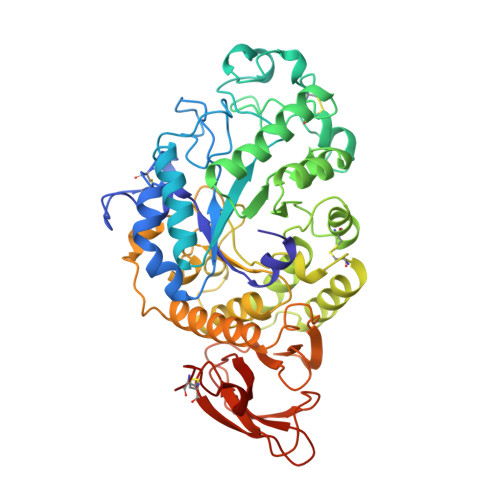Structure of the Aspergillus oryzae alpha-amylase complexed with the inhibitor acarbose at 2.0 A resolution.
Brzozowski, A.M., Davies, G.J.(1997) Biochemistry 36: 10837-10845
- PubMed: 9283074
- DOI: https://doi.org/10.1021/bi970539i
- Primary Citation of Related Structures:
7TAA - PubMed Abstract:
The three-dimensional structure of the Aspergillus oryzae alpha-amylase (TAKA-amylase), in complex with the inhibitor acarbose, has been determined by X-ray crystallography at a resolution of 1. 98 A. The tetrasaccharide inhibitor is present as a hexasaccharide presumably resulting from a transglycosylation event. The hexasaccharide occupies the -3 to +3 subsites of the enzyme, consistent with the known number of subsites determined by kinetic studies, with the acarbose unit itself in the -1 to +3 subsites of the enzyme. The transition state mimicking unsaturated pseudo-saccharide occupies the -1 subsite as expected and is present in a distorted 2H3 half-chair conformation. Careful refinement plus extremely well-resolved unbiased electron density suggest that the hexasaccharide represents a genuine transglycosylation product, but the possibility that this apparent species results from an overlapping network of tetrasaccharides is also discussed. Catalysis by alpha-amylase involves the hydrolysis of the alpha-1,4 linkages in amylose with a net retention of the anomeric configuration, via a double-displacement mechanism, as originally outlined by Koshland [Koshland, D. E. (1953) Biol. Rev. 28, 416-336]. The enzymatic acid/base and nucleophile, residues Glu230 and Asp206, respectively, are appropriately positioned for catalysis in this complex, and the hexasaccharide species allows mapping of all the noncovalent interactions between protein and ligand through the enzyme's six subsites.
Organizational Affiliation:
Department of Chemistry, University of York, Heslington, York YO1 5DD, England.
















